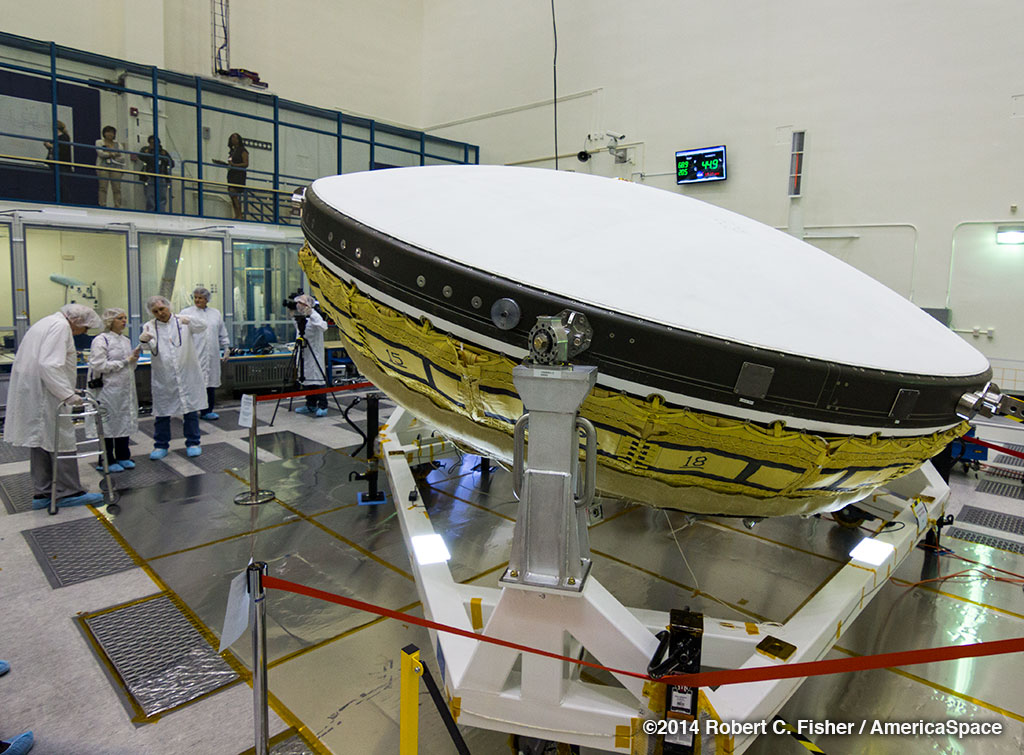
Anyone even remotely familiar with landing spacecraft and payloads on other worlds can respect how difficult such a feat really is, and it only gets more difficult as the spacecraft get larger and heavier. Mars rovers Spirit and Opportunity, each roughly the size of a golf cart, had to parachute in and land while cocooned inside a set of very sophisticated airbags, bouncing along the surface until coming to a stop. The rover Curiosity, which landed on Mars in August 2012, is the size of a SUV and carried out what is arguably the riskiest landing attempt of any spacecraft to date, touching down via a “sky-crane” which hovered thanks to rockets to lower the rover onto the surface.
Thing is, if NASA hopes to send larger spacecraft and payloads (including crews and large amounts of supplies) to an asteroid and Mars, such as those missions planned for NASA’s Space Launch System and Orion spacecraft, then the agency needs a new approach, and the Low-Density Supersonic Decelerator (LDSD) project is just that, a new way of landing large payloads on other worlds (and our own). NASA is also very restricted on where they can land; the Martian atmosphere is so thin that current deceleration technologies do not allow for the time needed to slow down enough to land at higher elevations. LDSD will open up many more options for future locations by enabling landings at regions that cannot be currently accessed.
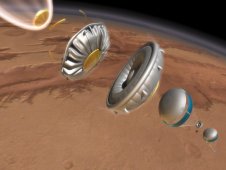
“If we’re going to explore an asteroid and eventually put people on the surface of Mars then we need sustained and significant investment in new space technologies. Without those investments we won’t be able to take people in any sustained way beyond low-Earth orbit,” said Jeff Sheehy, Senior Technical Officer of Space Technology Mission Directorate from NASA Headquarters. “Assume we can land something twice as big as Curiosity, what could we do with that? Where could we explore? How much MORE could we explore? How much more could we learn? We’re looking forward to sample returns from Mars and putting enough cargo on Mars to support human exploration, and the LDSD project aims at providing the technologies for entry, descent, and landing, which is one of the major challenges for sustained exploration of Mars.”
The current technology used for decelerating from a high speed atmospheric entry to the final stages of landing on Mars dates back to NASA’s Viking Program in 1976, and the same basic parachute design has been used ever since. LDSD brings a much needed upgrade; the heavier landers of the future will instead use atmospheric drag as a solution, which will save rocket engines and fuel for final maneuvers and landing procedures. LDSD will also give NASA the capability to land payloads of up to 3 tons, twice what can currently be landed, while also improving landing accuracy from the current margin of 10 kilometers to a mere three kilometers.
“We have been using the same Viking parachute design and the same supersonic Viking parachute test data from 1972 to qualify and validate the operation of our parachutes on all of our Mars missions,” said Mark Adler, LDSD Project Manager at JPL. “We’ve been pushing the limits of what we can squeeze out of that data, and we’re pretty much there, we’re at the limit. That would be fine if that’s all we wanted to do, but we want to go bigger, we keep getting bigger, we went from Sojourner to MER to Curiosity but that’s not good enough, we want to land bigger things, and we want to land them at higher altitudes and land more accurately.”
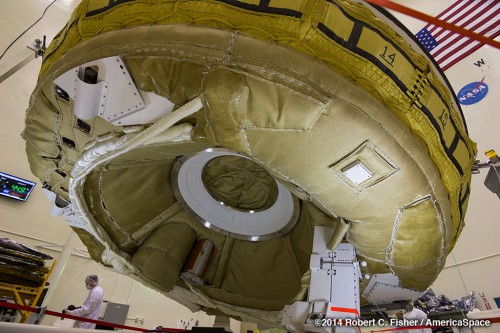
“The fundamental problem we have is things start going faster and faster through the Mars atmosphere as they get larger, and so we have to slow them down at higher altitudes and higher speeds,” added Adler. “Today we slow things down at about Mach 2, we’re going to have to go up to Mach 3 or Mach 4 and higher to start slowing bigger things down and that’s what this project is all about, developing new supersonic decelerators to slow things down at higher speeds.”
The LDSD project team has already completed three successful rocket sled tests of the “SIAD-R,” one of two Supersonic Inflatable Aerodynamic Decelerators that make up the three innovative deceleration systems now in development under the LDSD project (two SIADs of different sizes and an advanced parachute system). The tests on the balloon-like pressure vessel, which is designed to inflate around a vehicle and slow its entry, went well, despite the fact the test team put the SIAD-R through aerodynamic loads 25 percent greater than it will face during atmospheric entry at Mars.
“We inflated the SIAD-R on a rocket sled going about 250 mph to show that it could take the loads at Mars, so we simulated the loads this thing will actually experience when it actually lands at Mars,” said Adler. “We had to show that it would survive, that it inflated properly and wouldn’t rip off and show that it had the right characteristics that we would expect in a Mars flight. That all worked out great.”
A team from NASA’s Jet Propulsion Laboratory will conduct the first full-scale, stratospheric tests with the LDSD engineering test article high above the waters off Hawaii as soon as June 3. Launching from the U.S. Navy’s Pacific Missile Range Facility in Kauai, Hawaii, a 34-million-cubic-foot helium balloon will lift a solid-rocket powered test vehicle to an altitude of 120,000 feet, at which point the vehicle will fire a large Star-48 rocket motor to accelerate to supersonic speeds and reach 180,000 feet where the atmosphere of Mars can be simulated.
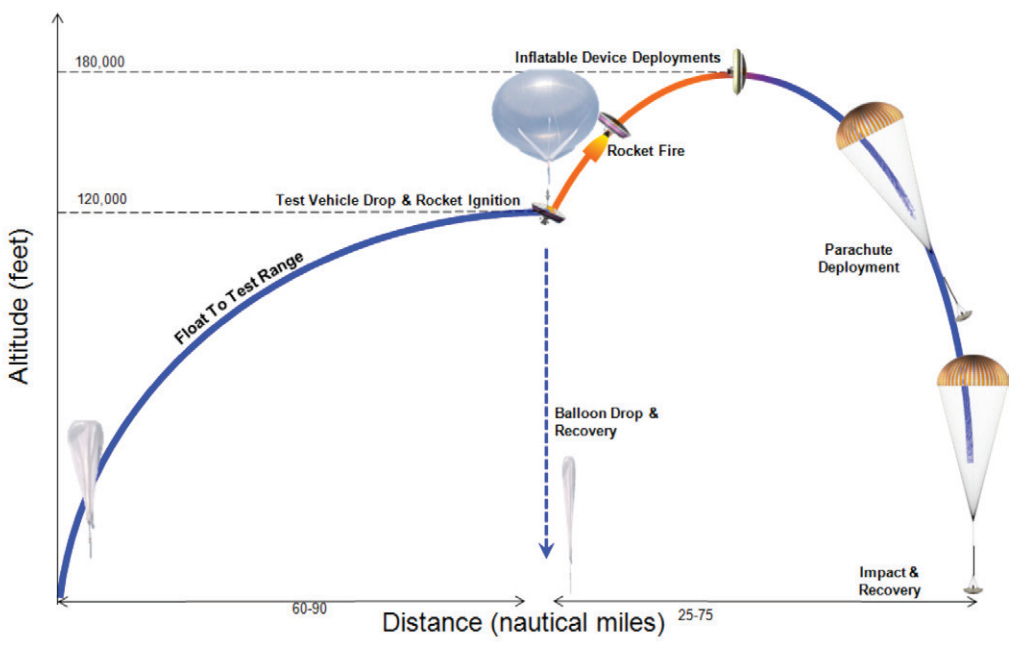
“We get to the altitudes of Mars in terms of density that we would be at when we conduct our flights there, then we fly horizontally at Mach 4. At about Mach 3.75 we will deploy the SIAD, which is where it has to deploy at Mars to start slowing us down at higher speeds,” said Adler. “Shortly after that we will deploy the parachute deployment device at Mach 2.75, then the parachute will come out at about Mach 2.5, then the whole thing comes down. So the whole test occurs in this horizontal phase at high altitude and we get all our data. We have tons of cameras, GPS, temperature sensors, pressure sensors, load cells and so on to give us information about these articles in flight so we can measure the dynamics, their performance, and so on to prove to ourselves that it will work at Mars if we did this there.”
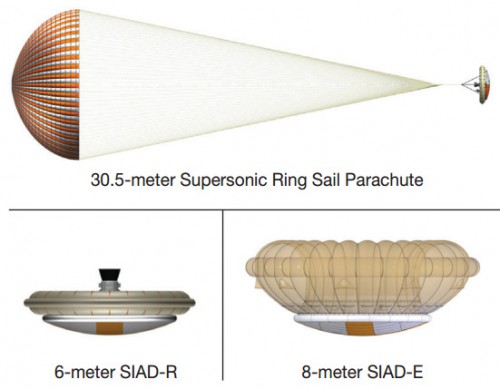
Two SIADs, which were inspired by a puffer fish’s ability to change its size rapidly without changing its mass, are being developed to serve two different purposes. A 20-foot-diameter (6-meter) SIAD will serve for landing smaller robotic payloads, and a 26-foot-diameter (8-meter) SIAD is being developed for landing larger payloads, including crews. The 100-foot-diameter parachute is also new; it’s twice as big as the parachute Curiosity used to land on Mars. It’s so big that it can’t even be tested in the world’s largest wind tunnel at AMES Research Center, instead the LDSD team had to conduct scale model tests to design the parachute for the actual flights. All three devices will be the largest of their kind ever flown at speeds several times greater than the speed of sound.
A series of flight tests are scheduled to take place in Hawaii through 2015, and the technology that comes from the LDSD project will be ready to support the missions it is designed for as soon as 2018. However, it may have to wait several more years before NASA has a reason to use it, because the space agency won’t be launching anyone anywhere until at least 2021, when the Space Launch System (SLS) and Orion spacecraft are scheduled to conduct the first crewed “deep-space” mission beyond low-Earth orbit. And if Congress continues to under-fund NASA, then it could be even longer before the missions that will need LDSD come to reality.
BELOW: Additional photos from our visit with the LDSD in the clean room at NASA’s Jet Propulsion Laboratory in Pasadena, Calif., on April 9. All photos credit Robert Fisher for AmericaSpace. Images copyright 2014, all rights reserved, unauthorized use is prohibited.
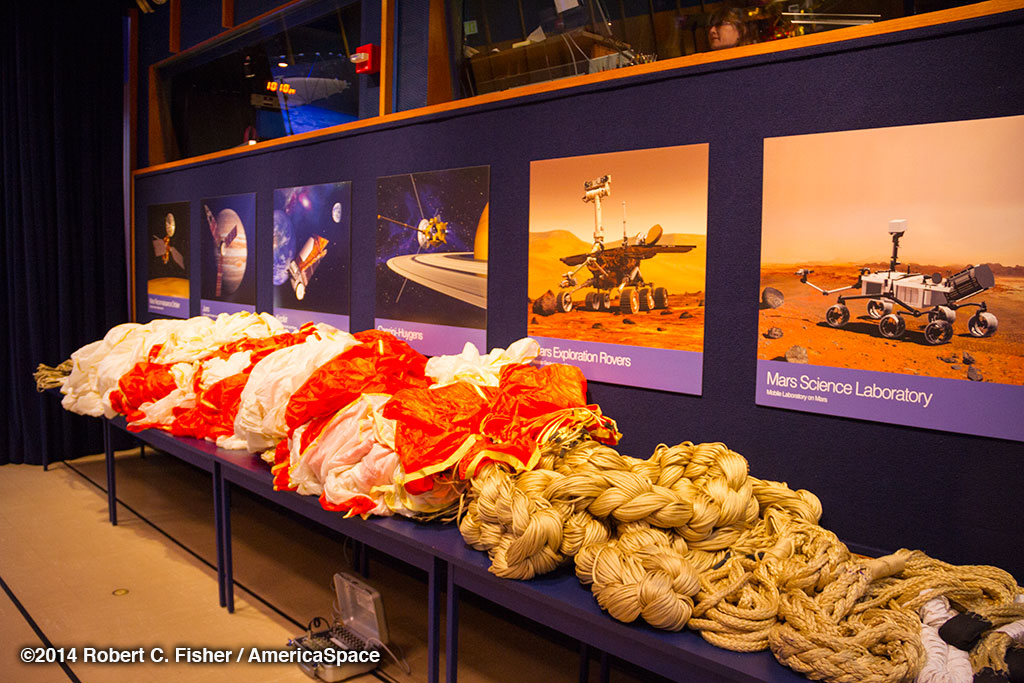
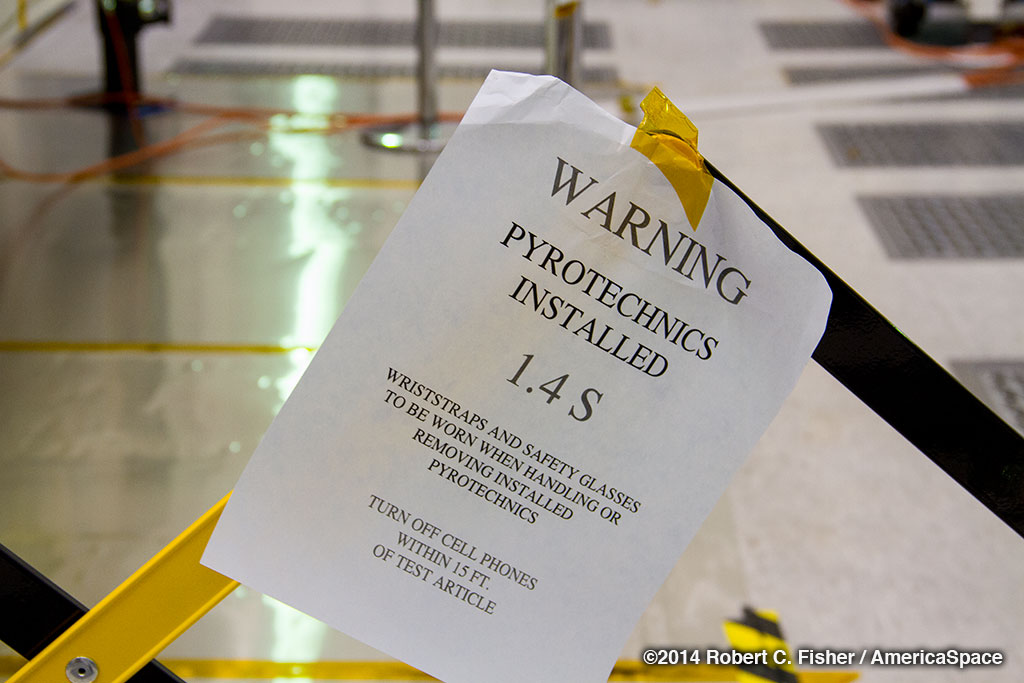
– Want to keep up-to-date with all things space? Be sure to “Like” AmericaSpace on Facebook and follow us on Twitter: @AmericaSpace




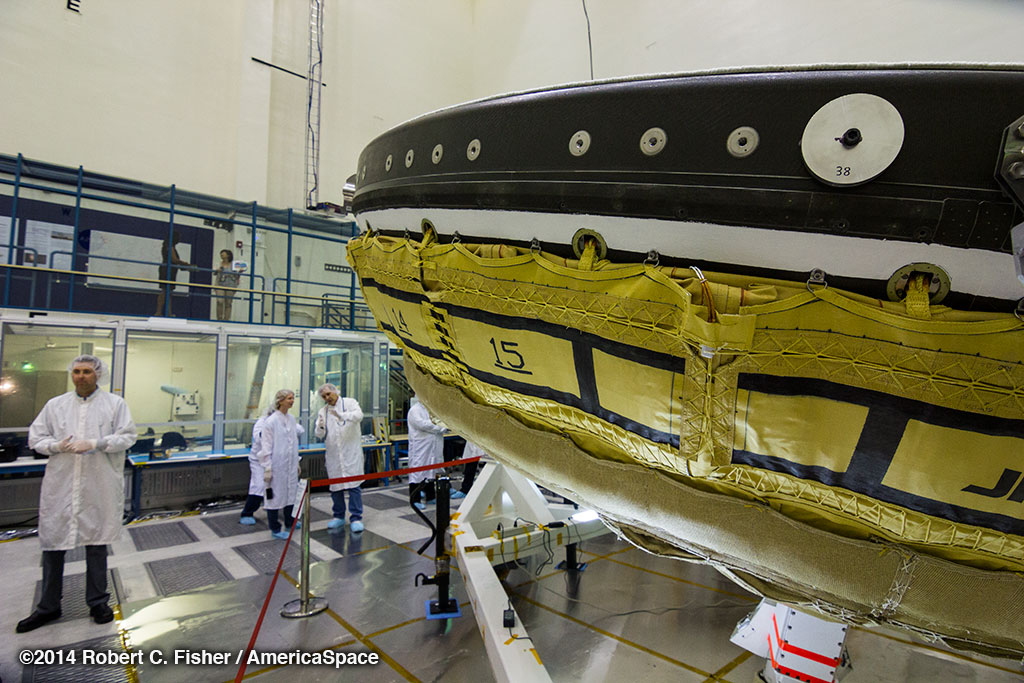
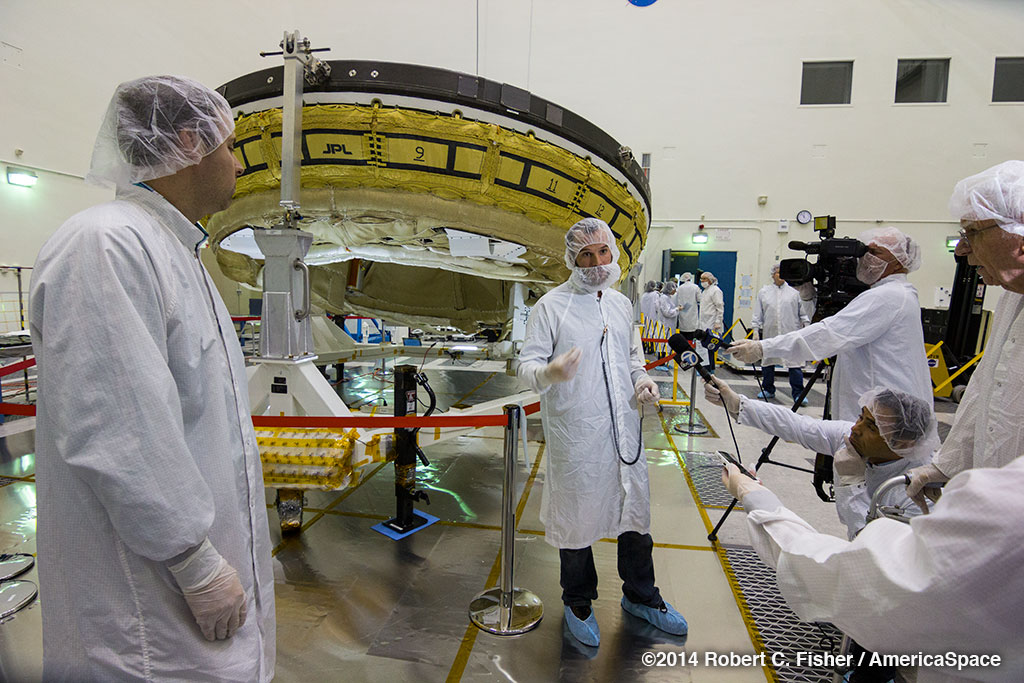
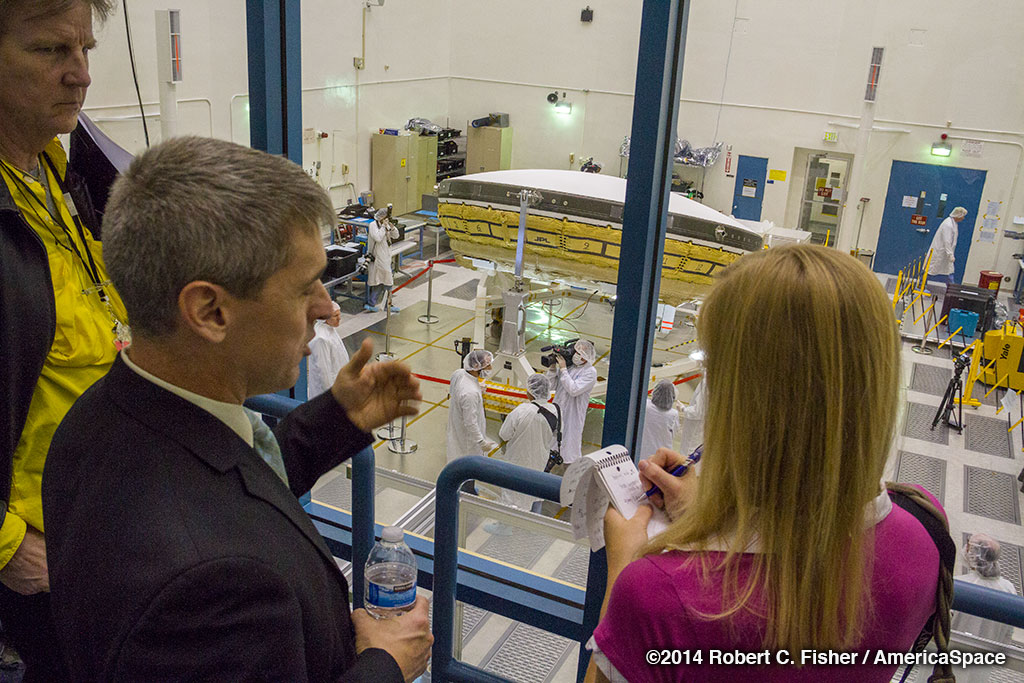
Really great article Mike! Indeed, that’s the kind of technology development needed, if we ever want to realise the dream of seeing people on Mars.
Agree, very well written. It’s good to see NASA doing this basic research. The irony may be that it’s easier to land something big like the SpaceX MCT than smaller vehicles that don’t use the thin martian atmosphere as well.
Typical NASA waste.
This is exactly what is wrong with NASA.
A private company that actually wants to continue to stay in business wouldn’t do something this dumb. It’s the equivalent of Mercedes developing a brake better then the disk break, but then have no plans to actually use it. They wouldn’t do that, you invent something, then you capitalize on it. NASA just squanders out tax dollars on something like this, only to then shelve it. Which is basically the “NASA way”. Then whey complain that they didn’t get all “their” billions that they had hoped to get from congress, Their basically an alcoholic that wont admit they have a drinking problem.
Excellent article!
To Derek: WRONG WRONG WRONG!!! While I’ve been known to throw some darts at NASA in the past, all too frequently in fact, this project is NOT wasteful by any stretch of the imagination. Save your ammo for the right targets. If I could pick one NASA project to increase the budget on, it would be this one. WE NEED THIS NEW CAPABILITY NOW, not ten or even three years from now. We can only develop new payloads and mission plans once we know acceptable mass and volume specs, a process that takes years of advance planning and funding. We will most definitely use this new landing system both inside NASA and outside (SpaceX, Mars-One, etc), and if it’s ready soon enough (i.e. now), I’d expect it to fly no later than 2018.
To Mark and friends – keep up the great work!